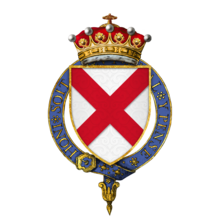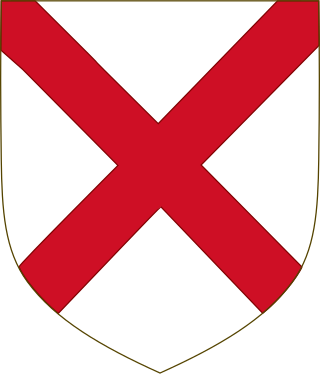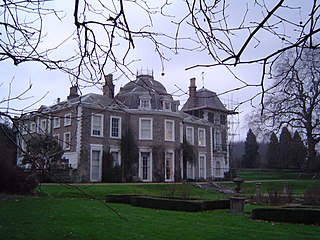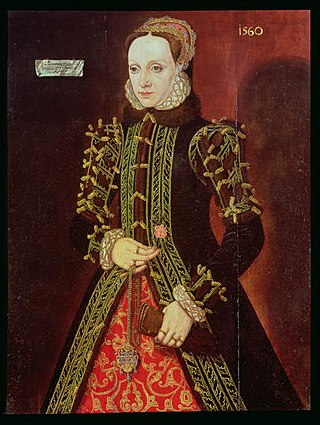
Gerald FitzGerald, 14th Earl of Kildare (died 11 February 1612) was an Irish peer. Much of his adult life was dominated by litigation with relatives over the Kildare inheritance.

Gerald FitzGerald, 14th Earl of Kildare (died 11 February 1612) was an Irish peer. Much of his adult life was dominated by litigation with relatives over the Kildare inheritance.
Lord Kildare was the son of Edward FitzGerald, younger son of Gerald FitzGerald, 9th Earl of Kildare and his second wife Elizabeth Grey, a cousin of Henry VIII. Edward married Agnes Leigh, daughter of Sir John Leigh of Stockwell, Surrey, [1] who was a half-brother of Queen Catherine Howard, the fifth queen of Henry VIII, both of them being children of Joyce Culpepper. Agnes was the widow of Sir Thomas Paston, of the famous Norfolk family who produced the Paston Letters.
Lord Kildare was knighted in 1599 and succeeded his cousin William as Earl of Kildare that same year. He served as Governor of Offaly in 1600 and was Commissioner of Connaught in 1604. [1]
The last decade of his life was much troubled by a long-running lawsuit brought against him by his cousin Lettice and her husband. [2] Lettice, only child of the eldest son of Gerald FitzGerald, 11th Earl of Kildare and his countess, Mabel Browne, had expected to inherit a substantial part of her grandfather's estate, but shortly before his death in 1585 she was disinherited by deed. In 1602 she sued both Kildare and her aged grandmother, alleging that Countess Mabel had forged or fraudulently altered the deed and that Kildare as a result was unlawfully in occupation of her property. Kildare filed a countersuit alleging, rather implausibly, that the action was collusive and that Mabel and Lettice were conspiring to deprive him of his property. [3] The case, which became quite celebrated, dragged on for years with hearings in several courts in both London and Dublin. Kildare complained bitterly of the disgrace to his honour and impoverishment of his estate, but was unable to bring proceedings to a resolution; the case continued even after both he and Mabel were dead. [4]
Lord Kildare married his cousin Elizabeth Nugent, daughter of Christopher Nugent, 5th Baron Delvin and Lady Mary FitzGerald, daughter of the 11th Earl of Kildare. [5] [6] She was still living in 1634, when she leased Kilkea Castle, County Kildare, a long-standing FitzGerald residence, to the Jesuit Order.
He died suddenly at Maynooth in February 1612 after complaining of a "pain in his stomach" [4] and was succeeded in the earldom by his infant son, Gerald, who died young in 1620. [1]

Duke of Leinster is a title and the premier dukedom in the Peerage of Ireland. The subsidiary titles of the Duke of Leinster are: Marquess of Kildare (1761), Earl of Kildare (1316), Earl of Offaly (1761), Viscount Leinster, of Taplow in the County of Buckingham (1747), Baron of Offaly, Baron Offaly (1620) and Baron Kildare, of Kildare in the County of Kildare (1870). The viscounty of Leinster is in the Peerage of Great Britain, the barony of Kildare in the Peerage of the United Kingdom, and all other titles in the Peerage of Ireland. The courtesy title of the eldest son and heir of the Duke of Leinster is Marquess of Kildare. The Duke of Leinster is the head of the House of Kildare.

The FitzGerald dynasty is a Hiberno-Norman noble and aristocratic dynasty, originally of Cambro-Norman and Anglo-Norman origin. They have been peers of Ireland since at least the 13th century, and are described in the Annals of the Four Masters as having become "more Irish than the Irish themselves" or Gaels, due to assimilation with the native Gaelic aristocratic and popular culture. The dynasty has also been referred to as the Geraldines and Ireland's largest landowners. They achieved power through colonisation and the conquest of large swathes of Irish territory by the sons and grandsons of Gerald de Windsor. Gerald de Windsor was the first Castellan of Pembroke Castle in Wales, and became the male progenitor of the FitzMaurice and FitzGerald Dynasty. His father, Baron Walter FitzOther, was the first Constable and Governor of Windsor Castle for William the Conqueror, and was the Lord of 38 manors in England, making the FitzGeralds one of the "service families" on whom the King relied for his survival. Some of its members became the Black Knights, Green Knights and White Knights.

Catherine Carey, after her marriage Catherine Knollys and later known as both Lady Knollys and Dame Catherine Knollys,, was chief Lady of the Bedchamber to Queen Elizabeth I, who was her first cousin.
There have been two creations of the title Baron Offaly, both in the Peerage of Ireland.

Lord Edmund Howard was the third son of Thomas Howard, 2nd Duke of Norfolk, and his first wife, Elizabeth Tilney. His sister, Elizabeth, was the mother of Henry VIII's second wife, Anne Boleyn, and he was the father of the king's fifth wife, Catherine Howard. His first cousin, Margery Wentworth, was the mother of Henry's third wife, Jane Seymour.

Sir Francis Knollys, KG of Rotherfield Greys, Oxfordshire was an English courtier in the service of Henry VIII, Edward VI and Elizabeth I, and was a Member of Parliament for a number of constituencies.

Gerald FitzGerald, 11th Earl of Kildare, also known as the "Wizard Earl", was an Irish peer. He was the son of Gerald FitzGerald, 9th Earl of Kildare and his second wife Elizabeth Grey of the Royal House of Grey.

Gerard FitzGerald, 9th Earl of Kildare, was a leading figure in 16th-century Irish History. In 1513 he inherited the title of Earl of Kildare and position of Lord Deputy of Ireland from his father.
Elizabeth FitzGerald was the first wife of Lucas Plunket, who succeeded as Baron Killeen in 1613, and who in due course became the 1st Earl of Fingall in 1628. They lived at Killeen Castle, County Meath in Ireland. She was a daughter of Henry FitzGerald, 12th Earl of Kildare, and therefore sister to Bridget, the Countess of Tyrconnell and wife of Prince Rory O'Donnell, 1st Earl of Tyrconnell.

Jocasta "Joyce" Culpeper, of Oxon Hoath was the mother of Catherine Howard, the fifth wife and Queen consort of King Henry VIII.

Elizabeth FitzGerald, Countess of Lincoln, also known as "The Fair Geraldine", was an Irish noblewoman and a member of the celebrated FitzGerald dynasty. She became the second wife of Sir Anthony Browne and later the third wife of English admiral Edward Clinton, 1st Earl of Lincoln. She was the inspiration for The Geraldine, a sonnet written by Henry Howard, Earl of Surrey.
Mabel Browne, Countess of Kildare was an English courtier. She was wife of Gerald FitzGerald, 11th Earl of Kildare, Baron of Offaly. She was born into the English Roman Catholic Browne family whose members held prominent positions at the courts of the Tudor sovereigns for three generations. Mabel served as a gentlewoman of Queen Mary I's privy chamber, and enjoyed the Queen's favour.
Katherine FitzGerald, suo jure Viscountess Grandison (1660–1725), was a wealthy Irish heiress, being the only child of Sir John FitzGerald of Dromana, County Waterford. She inherited the Dromana estate in 1664 upon the death of her father. She was married three times; firstly to John Le Poer, 2nd Earl of Tyrone; secondly to Brigadier-General, Hon. Edward FitzGerald-Villiers; and thirdly and lastly to General William Steuart.
Lady Elizabeth FitzGerald, Countess of Kildare, was an Anglo-Irish noblewoman, the second wife of Gerald FitzGerald, 9th Earl of Kildare. Her father was Thomas Grey, 1st Marquess of Dorset. Her mother, Cecily, was the wealthiest heiress in England after succeeding to the title of suo jure 7th Baroness Harington of Aldingham and then the title of suo jure 2nd Baroness Bonville.
Sir Christopher Nugent, 6th Baron Delvin (1544–1602) was an Irish nobleman and writer. He was arrested on suspicion of treason against Queen Elizabeth I of England, and died while in confinement before his trial had taken place.

Margaret Butler, Countess of Ormond, Countess of Ossory was an Irish noblewoman and a member of the powerful and celebrated FitzGerald dynasty also known as "The Geraldines". She married Piers Butler, 8th Earl of Ormond, by whom she had three sons and six daughters.
Lettice FitzGerald, 1st Baroness Offaly was an Irish noblewoman and a member of the FitzGerald dynasty. Although she became heiress-general to the Earls of Kildare on the death of her father, the title instead went to the next FitzGerald male heir when her grandfather, the 11th Earl of Kildare, died in 1585. In 1620, she was created suo jure Baroness Offaly by King James I of England.
Henry Burnell was an Irish judge and politician; he served briefly as Recorder of Dublin and as a justice of the Court of King's Bench. Though he was willing to accept Crown office, he spent much of his career in opposition to the Government. He was one of the leaders of the protest against the policies of the Lord Deputy of Ireland Sir Henry Sidney in the late 1570s, and as a member of the Irish House of Commons in the 1580s he successfully opposed Sidney's successor, Sir John Perrot. In the early 1600s, he was one of the leaders of the protest against strict enforcement of the Penal Laws. His professional reputation was gravely damaged in his later years by a verdict that he was guilty of forgery, when he was convicted and fined for having altered a deed concerning the inheritance of the 11th Earl of Kildare's estate. He was the grandfather of the playwright Henry Burnell.
Sir Robert Digby PC(I) was an English courtier who owned an estate at Coleshill, Warwickshire. His marriage to Lettice FitzGerald, heir-general to the 11th Earl of Kildare, led him to spend his life litigating over her claims to the Kildare lands. He divided his time between local business in Warwickshire and in Ireland.
Elizabeth Nugent was an Irish noblewoman from an Old English family, and a major patron of the Jesuit order in Ireland. Her marriage to Gerald FitzGerald gave her the title of Lady Kildare, and after his death she became known as the Dowager Countess of Kildare.